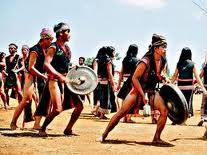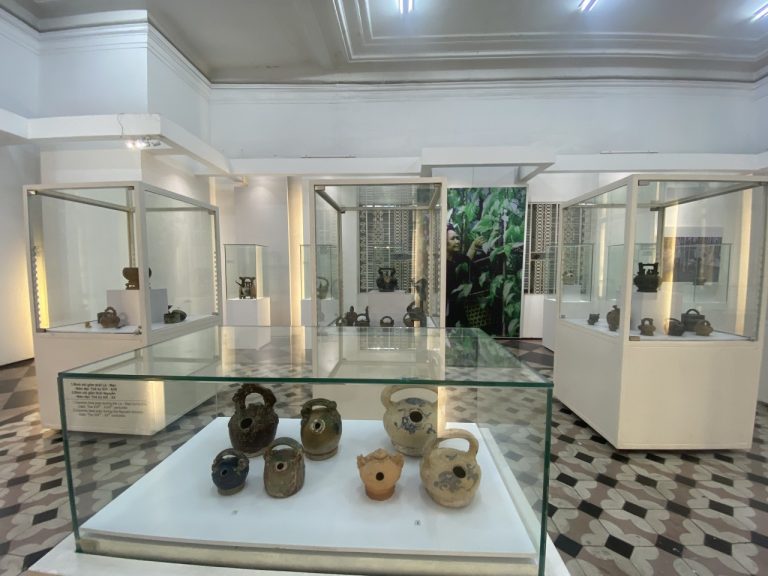Ho Chi Minh City Museum hold this exhibition, in collaboration with the VICAS. This is one of the activities executing the national programme of preservating and developing the value of the Cultural Space of Central Highland Gong Music. These old photos, hitherto unpublished in Viet Nam, allow us to go back in time and seek a fuller understanding of the strong tradition among the inhabitants of Viet Nam’s Central Highlands.
The photographs do not cover the Gong music of all the region’s ethnic minorities, representing no more than the study sites and individual interests of the people who took them. The Mission Étrangère do Paris photos were mostly taken among the Bahnar community in KonTum. Many of these pictures were taken by Father Christian Simonet, official photographer of the Mission Étrangère do Paris in this region from 1950 to 1955.
Other photo were taken by French scholars who lived for many years in the communities which they studied. For example, Georges Condominas lived with the Mnong Gar, Jaques Dournes with the Jarai, Jean Boulbet with the Ma. Their photos usually magnificent and perfectly documented are invaluable evidence of a intangible heritage which is now in danger of disparity.
They were taken from the 1930s to the 1960s and are kept in the archives of the École Francais d’Extrême – Orient, Mission Étrangère de Paris and Quai Branly Museum. They testify to the interest shown by French colonial officials, military officers, missionaries and scholars for this art.
This exhibition includes four parts: Gong orchestra, Gong playing and the outside world, Gong players and Gong music in context.
 |
 |
 |
 |
Gong orchestra
By contrast from the musical instruments which can be played solo, gongs are always played in an orchestra. Each gong has a fixed position in the orchestra and sounds only one musical note.
The Giarai and Bahnar possess different kinds of gong orchestras. The most improtant gong is the cing arap. Among the Giarai, it consists of 13 different gongs (five bossed gongs and eight flat gongs) and among the Bahnar of 11 gongs (three bossed gongs and eight flat gongs).
The cing Mnhum orchestra has nine pieces: six flat gongs and three bossed gongs, played during festival when wine is drunk from the jar. The cing trum consists of three bossed gongs and one or two drums. The Ede also have gong sets of great renown, usually played in the long house alongside a large drum.
The Mnong Gar, the Ma and the Sre (Cơho) possess sets of six gongs of different sizes. For the Mnong Gar, the biggest gong “cing mei”, “mother” marks the beat: it is 40cm in diameter. The smallest gong measures only about 17cm, this fifth gong is the most difficult to use and plays the melody.
The drum is also part of the gong orchestra; it controls the tempo. The drummer also acts as the orchestra’s conductor: he gives signals for other players to stop or start and decides the music’s rhythm and intensity.
As a general rule, gong orchestras are made up exclusively of men; among the Ma and the Ede, however, women also play.
Gong playing and the outside world
An essential tradition of the Central Highlands, gong music has of great interest to visitors from afar. All the late nineteenth and early twentyth-century explorer and travelers mentioned gongs in their accounts. At the beginning of the colonial period, soldiers and officials attended important festivals, usually the buffalo sacrifice rituals that were accompanied by gongs performance. The earliest photographs show local people possing with gongs. These images were used on postcards from the first year of the twentieth century.
Buffalo sacrifices and gong performances also played a central role in activities that had no connection with local traditions. Examples of this include the inauguration ceremony of Road 14 in 1937 and the welcome extend to a Christian nun by a youth orchestra in a Bahnar village.
Gong players
Gongs are made of alloys consisting of cooper, some other metals and sometimes – for the most precious – silver. They are not made in the Central Highlands: the most ancient are bought from Lao people, while the more recent, less valuable pieces are obtained from the Kinh. The sound quality depends on the alloy used and the subtle art of tuning, done by striking the gongs’ inner surface with an iron hammer, a hard wooden mallet, ect… The bossed gong is usually played by striking its nipple with a wooden mallet wrapped in cloth or leather at one end. The Jarai, the Bahnar and the Ede play the flat gong by striking on its inner surface with a green wooden mallet. The Mnong, the Ma and the Coho use their right fist to beat the flat gong and their left hand to adjust the sound by applying pressure on the inner surface.
When playing, Ede people usually sit on the great bench in the long home’s “reception room”. Among other ethnic minorities, gongs are commonly played standing: the players from a line and move in an anti-clockwise direction around the ritual’s central point. Small light gongs are held with the hands or suspended from the shoulders on a string. Heavy gongs are suspended on a big stick carried by two people, too heavy to be carried, are never taken out of the house.
Gong music in context
Traditionally, gongs are only played during rituals. Gongs are present at all village festivals and on important life occasions. All the rituals of the life cycle are celebrated with a gong concert. Family life is thus frequently marked by gong music events.
During all this funeral rituals, the Jarai and Bahnar use a great orchestra which may consist of up to 13 gongs, a drum and sometimes even a cymbal. The drum orchestra, with its three bossed gongs and one or two drums, is usually played at the buffalo sacrifices organized for many occasions.
Most populations play gongs when a new house is inaugurated and at most family rituals. The most important of these are the rites of passage for boys as well as girls: they differ from one ethnic group to the next. Birth to death rituals especially the important funeral rites use all celebrated with gong music.
The festivities of the agricultural cycle such as the propitiatory ceremony before sowing and the votive ceremony after the harvest are also celebrated with gong music.





